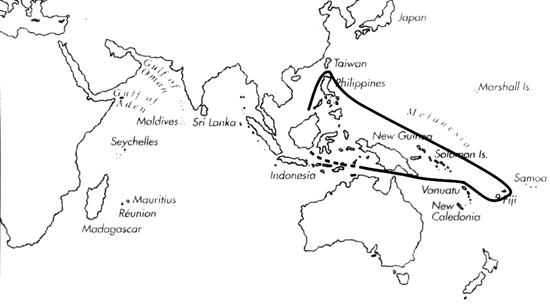Range: Philippines, Papua New Guinea, Solomon Is. and Fiji.
Description: Medium-sized to moderately large, moderately solid to solid. Last whorl ventricosely conical, sometimes ovate; outline convex at adapical third, less so or straight below, often with a straighter right side. Siphonal fasciole prominent and siphonal notch often slightly curved to dorsal side. Shoulder subangulate or rounded. Spire of moderate height, outline concave to sigmoid. Larval shell multispiral, maximum diameter 0.8-1.0 mm. Teleoconch sutural ramps flat to slightly concave, with 1-2 increasing to 2-6 spiral grooves; additional spiral striae on last 2 ramps. Last whorl with closely and widely spaced, narrow and wide spiral grooves on a varying portion of basal half; grooves separating ribs and ribbons in irregular sequence, with the former predominantly occurring basally and the latter adapically.
| Shell Morphometry | ||
|---|---|---|
| L | 45-70 mm | |
| (50-78 mm mm (Palawan variant)) | ||
| RW | 0.16-0.40 g/mm | |
| (L 45-61 mm; 0.18-0.40 g/mm mm (Palawan variant)) | ||
| RD | 0.52-0.60 | |
| (0.49-0.52 mm (Palawan variant)) | ||
| PMD | 0.72-0.85 | |
| RSH | 0.11-0.17 | |
Ground colour white to cream. Last whorl with light yellow to tan spiral and axial zones, blending with adjacent ground-colour areas and sometimes covering a large portion of last whorl; occasionally 3 spiral colour bands, located below shoulder and on each side of centre. Irregularly arranged dark brown spots, flecks and flammules of varying numbers are often seen in Philippines shells (Pl. 18, Figs. 23, 25) and rarely in shells from Papua New Guinea (Pl. 18, Figs. 24). Variant from Palawan, Philippines (Pl. 18, Fig. 26, 27) with 3 tan spiral bands on last whorl, crossed by long interrupted or continuous dark brown axial streaks or flames extending from shoulder ramp to base or nearly so. Base light yellow to tan except for nearly white shells from Papua New Guinea. Larval whorls white to pale brown; adjacent sutural ramps solid brown. Later sutural ramps pale grey, often tinged with yellowish tan, with sparse and faint to many pronounced brown radial markings. Aperture yellow to orange behind a lighter marginal zone.
Periostracum dark brown, moderately thick, opaque, and velvety.
Foot yellowish brown (Richards, 1988).
Radular teeth with a rather uniformly narrow shaft and hardly any adapical armature; serration short, with 5-8 blunt denticles; centre of shaft with a cusp, base with a spur (Röckel, 1985b).
Habitat and Habits: In 10-30 m, on sand and mud bottoms.
Discussion: C. flavus was referred to by Petuch (1974) as a "light color variety" of C. pilkeyi. Sympatric C. ochroleucus often differs from C. flavus in having a narrower last whorl (RD 0.47-0.54) with a straighter outline. C. ochroleucus lacks dark brown axial markings on the last whorl of adult specimens, while C. flavus lacks marginal spots on the middle sutural ramps. C. o. ochroleucus can also be distinguished by its angulate shoulder, and by shape and armature of its radular teeth. C. o. tmetus differs additionally in its mostly dark last whorl with a contrasting light base. In spite of a narrower last whorl, somewhat lighter weight, weaker sculpture on the last whorl and a pronounced axially lineate pattern, the variant from Palawan (Pl. 18, Figs. 26, 27) shares all other characters with C. flavus from other Philippine localities. We thus assign these shells to this species.

C. flavus range map
This section contains verbatim reproductions of the accounts of 316 species of Conus from the Indo-Pacific region, from Manual of the Living Conidae, by Röckel, Korn and Kohn (1995). They are reproduced with the kind permission of the present publisher, Conchbooks.
All plates and figures referred to in the text are also in Röckel, Korn & Kohn, 1995. Manual of the Living Conidae Vol. 1: Indo-Pacific Region.
The range maps have been modified so that each species account has it own map, rather than one map that showed the ranges of several species in the original work. This was necessary because each species account is on a separate page on the website and not confined to the order of accounts in the book.